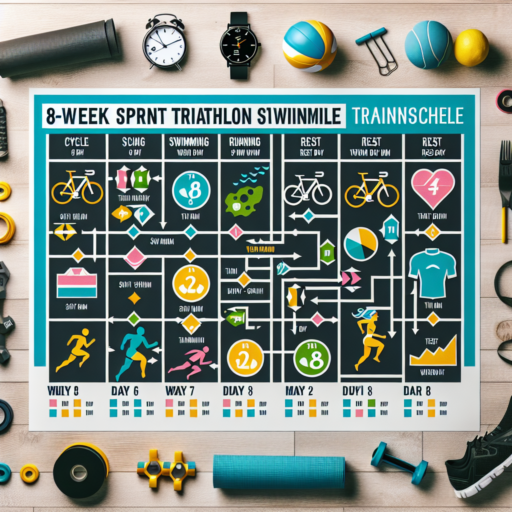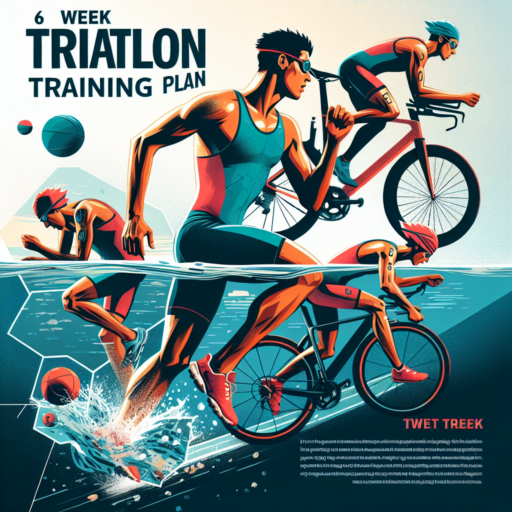Introduction to the 8-Week Sprint Triathlon Training Schedule
Embarking on an 8-week sprint triathlon training schedule is an exhilarating challenge that signifies the beginning of a rewarding journey for many athletes. This comprehensive guide is designed to map out an efficient and effective approach to prepare for the triathlon, ensuring participants can confidently tackle the swim, cycle, and run portions. Whether you’re a seasoned triathlete looking to sharpen your skills or a newcomer aiming to complete your first triathlon, this training plan accommodates a range of abilities and experiences.
The heart of this 8-week training schedule lies in its balanced approach to enhancing endurance, strength, and speed across all three disciplines involved in a sprint triathlon. Emphasizing progressive overload, the plan steadily increases the intensity and duration of workouts while incorporating sufficient recovery time. This strategy is critical for avoiding injuries, improving performance, and ensuring that athletes arrive at the start line in peak condition. Key components include structured swim drills, targeted cycling workouts, and strategic run sessions, all carefully calibrated to build up to race day.
Importantly, this training guide also underscores the value of flexibility within the schedule. Recognizing that life’s demands can fluctuate, it offers guidance on how to adjust workouts to fit personal schedules and when it might be necessary to scale intensity up or down. Nutritional recommendations, rest days, and tips for mental preparation are integrated into the schedule, offering a holistic approach to training. With dedication and adherence to the prescribed plan, athletes can look forward to achieving their sprint triathlon goals through this tailored 8-week journey.
Week 1-2: Building the Foundation for Your Sprint Triathlon
Embarking on the journey to participate in a sprint triathlon is thrilling, yet requires a meticulous approach to training, especially in the initial stages. The first two weeks, often referred to as the foundation phase, are critical in establishing a strong and resilient base that will carry you through to race day. During this period, the focus is on gradually increasing your endurance across swimming, cycling, and running, while also integrating strength training to enhance overall performance and prevent injuries.
Starting with Endurance
At the outset, it’s important to assess your current fitness level across the three disciplines. You don’t need to excel immediately, but understanding your starting point will guide your initial workouts. For swimming, begin with shorter distances focusing on form and gradually increase the length of your sessions. On the bike, aim for consistent, moderate-intensity rides to build leg strength and endurance. For running, incorporate a mix of short jogs and brisk walks, slowly increasing the time spent running. It’s essential to prioritize rest days to allow your body to recover and adapt.
Strength Training Integration
Incorporating strength training early on is key to preparing your body for the demands of a sprint triathlon. Focus on exercises that build core strength, stability, and flexibility. Planks, squats, and lunges are great starting points, offering comprehensive benefits that translate across all three triathlon disciplines. Additionally, dedicating time to improve shoulder strength can greatly enhance your swimming technique and efficiency. Emphasis on low-weight, high-repetition exercises helps in building endurance muscle fibers, vital for the later stages of triathlon training.
Ultimately, the initial weeks are about laying a solid foundation and gradually introducing your body to the multifaceted demands of sprint triathlon training. It’s not about intensity or mileage but building a routine that encompasses all aspects of triathlon training: endurance, strength, and recovery. Remember, consistency is more valuable than pushing yourself too hard, too soon.
Week 3-4: Increasing Endurance and Intensity
As you embark on Weeks 3 and 4 of your fitness journey, focusing on increasing endurance and intensity becomes crucial. This phase is designed to gradually challenge your body, encouraging improvements in both your stamina and strength. By carefully upping your workout intensity, you can enhance your cardiovascular health, burn more calories, and build muscular endurance without risking injury.
Strategies to Increase Endurance
- Incrementally increase your workout duration by 5-10 minutes each session.
- Introduce interval training to mix short bursts of high-intensity exercise with periods of low intensity, boosting your endurance over time.
- Incorporate a variety of cardiovascular exercises, such as running, cycling, and swimming, to engage different muscle groups and prevent boredom.
Boosting Your Workout Intensity
Increasing the intensity of your workouts is equally important. This not only aids in building muscle strength but also ensures that your body doesn’t plateau, continuously adapting and improving. To safely intensify your workouts, consider:
- Adding resistance or weight to your exercises. Even small increments can make a significant difference in the intensity of your workout.
- Reducing rest intervals between sets to keep your heart rate elevated, fostering both endurance and strength gains.
- Switching up your routine with cross-training. Engaging in different types of exercises can push your body out of its comfort zone, leading to greater improvements in overall fitness.
Week 5-6: Sharpening Your Skills in Swimming, Biking, and Running
As you transition into Weeks 5 and 6 of your training, it’s time to focus on sharpening your skills in swimming, biking, and running. This period is critical for enhancing your technique, building speed, and increasing efficiency in each discipline. Emphasizing these aspects will prepare you for the challenges ahead, ensuring you’re not just enduring but excelling in your triathlon journey.
In swimming, concentrate on perfecting your stroke technique. This includes refining your arm movements for reduced drag and improved propulsion, as well as working on your breathing technique to ensure you’re as efficient as possible. Drills such as catch-up strokes and fingertip drags can be immensely beneficial here. Transitioning to biking, focus on optimizing your body’s position for both comfort and aerodynamics. Fine-tuning your riding posture not only enhances your speed but also conserves energy for the running leg of the triathlon. Implement interval training to boost your cycling endurance and speed.
When it comes to running, this phase should prioritize improving your stride efficiency and pace. Tempo runs and interval sessions are key to increasing your running economy, helping you to maintain a solid pace without overexerting. Additionally, incorporating strength training exercises specific to runners can prevent injuries and improve overall performance. Paying attention to your body’s feedback during these weeks is crucial, as it will guide necessary adjustments to your technique across all three disciplines.
Week 7: Taper and Recovery Before the Sprint Triathlon
Entering Week 7 of your training for a sprint triathlon marks a pivotal shift towards tapering and recovery. The hard work, intense sessions, and accumulative fatigue are behind you. It’s now time to let your body and mind recover and fine-tune your readiness for race day. Tapering is not about halting progress but about maximizing the training benefits through strategic reduction in training volume and intensity.
Understanding the Tapering Process
Tapering involves gradually decreasing your training load to allow your body to mend and strengthen. This period is crucial for physiological and psychological reasons. Physiologically, your body repairs itself and adapts to the demands previously placed on it, resulting in improved performance. Psychologically, reducing the training intensity helps in relieving mental stress, enhancing focus, and building confidence. Aim to reduce your training volume by 20-30%, but maintain the training frequency to keep up with the race’s pace and feel.
Effective Recovery Strategies
- Focus on nutrition — Ensure your diet is rich in carbohydrates, proteins, and healthy fats to aid in recovery and energy storage.
- Stay hydrated — Keeping the body hydrated is key to recovery. Aim for at least 8 glasses of water a day, more if your last intense workouts have left you dehydrated.
- Quality sleep — Prioritize getting ample high-quality sleep; 7-9 hours per night is beneficial for recovery and mental sharpness.
- Stretching and mobility work — Incorporate light stretching and mobility exercises to enhance flexibility and reduce the risk of injuries.
Remember, the final week before your sprint triathlon is about conserving energy and sharpening your edge for the event. It’s tempting to push through one last hard workout, but the benefits of tapering and recovery far outweigh the temporary satisfaction of intense training at this stage. Embrace the tapering process and trust in the training you’ve put in; your body is now in its prime state for peak performance.Week 8: Final Preparations for Race Day
With the arrival of Week 8, it’s time to focus on the final preparations for race day. This crucial stage involves not just physical readiness but also mental preparation, nutrition adjustments, and finalizing the logistical aspects of the event. As you taper down your intense workouts, it’s essential to focus on activities that fine-tune your body and mind for optimal performance.
Prioritizing Rest and Recovery
At this juncture, rest becomes as important as your training. Engage in activities that promote recovery such as gentle stretching, yoga, or even light jogging. It’s about maintaining momentum without exhausting the body. Ensure you’re getting enough sleep, as this is when muscle repair and strength building primarily occur. Adequate sleep also sharpens your mental focus, a crucial element for race day success.
Nutritional Adjustments for Peak Performance
Your fueling strategy this week should focus on optimizing energy storage and hydration. Gradually increase your intake of complex carbohydrates to boost your glycogen reserves. However, avoid any drastic dietary changes that could upset your stomach. Stay hydrated by consistently drinking water and electrolyte-rich fluids. Remember, your nutrition and hydration strategy should be practiced and not experimented with at this phase.
In the lead-up to the race, also finalize logistical elements such as picking up your race pack, checking the weather forecast, and preparing your race day gear and nutrition. Having everything organized before race day can significantly reduce stress and enable you to focus on the race itself. Embrace the excitement, trust in your training, and look forward to achieving your goals.
Nutrition Tips for your 8-Week Sprint Triathlon Training
Embarking on an 8-week sprint triathlon training demands not just rigorous physical preparation but also meticulous nutritional planning. Adequate nutrition is the cornerstone of any successful athletic training regimen, providing the energy and nutrients necessary for maximum performance and recovery. Below are essential nutrition tips to optimize your training results and keep your body in peak condition.
1. Prioritize Carbohydrate Intake for Energy
To fuel the intense workouts characteristic of sprint triathlon training, incorporating sufficient carbohydrates into your diet is critical. Carbohydrates are your body’s primary energy source during high-intensity exercises. Opt for complex carbohydrates, such as whole grains, fruits, vegetables, and legumes, which provide a steady energy release and keep you powered throughout your training sessions.
2. Don’t Neglect Protein and Recovery
Protein plays a key role in repairing and rebuilding muscle tissue damaged during training. For a sprint triathlete, incorporating a balanced amount of high-quality protein sources, like lean meats, fish, eggs, and plant-based proteins, is crucial. Post-workout, consuming a protein-rich snack or meal can significantly enhance muscle recovery and prepare your body for the next training session.
3. Stay Hydrated and Supplement Smart
Hydration is another critical aspect of nutrition that can significantly impact your training and performance. Maintaining adequate fluid intake before, during, and after workouts prevents dehydration and supports overall health. Additionally, while whole foods should always be your first choice for nutrients, certain supplements like electrolytes, iron (if you are deficient), and omega-3 fatty acids might offer benefits, especially during intense training periods.
Essential Gear for Sprint Triathlon Training
Training for a sprint triathlon demands not just discipline and dedication but also the right gear to enhance performance and ensure safety. Whether you’re a novice embarking on your first triathlon journey or an experienced athlete fine-tuning your training, understanding the crucial equipment is imperative.
Swim Essentials
Embarking on the swimming segment, your gear can significantly influence your speed and stamina in the water. A high-quality, well-fitted wetsuit is essential for buoyancy and warmth in open water conditions. Equally important are a pair of goggles that offer clear visibility and comfort, together with a swim cap to reduce drag. Investing in these items can create a more streamlined and efficient swim.
Bike Training Gear
Moving onto the cycling phase, the importance of a reliable and lightweight bike cannot be overstated. It serves as the cornerstone for your cycling training, complemented by a correctly sized helmet for safety. Additionally, cycling shorts with padding can significantly increase comfort on long rides, and a pair of clipless pedals and shoes enhances your power transfer from legs to bike, making your training more effective.
Run Must-Haves
Lastly, for the running segment, investing in a quality pair of running shoes that fit well and offer good support is critical to prevent injuries and improve endurance. Incorporating technical clothing that wicks away sweat can also keep you comfortable and focused during long runs. A GPS watch can be a valuable tool to track your distance, pace, and overall progress, turning data into actionable insights for your training.
How to Avoid Common Injuries During Training
Preventing injuries during training sessions is crucial for maintaining a healthy and active lifestyle. Understanding the underlying causes and adopting preventative measures can significantly reduce the risk of suffering from common training-related injuries. There are several actionable steps you can incorporate into your training regimen to safeguard your body against potential harm.
Proper Warm-up and Cool-down Techniques
One key strategy in injury prevention is incorporating a comprehensive warm-up and cool-down routine into your training. Warm-up exercises gradually increase the heart rate and blood flow to the muscles, preparing them for the more vigorous activity to come, while cooling down helps to slowly bring your body back to its pre-exercise state. This can include dynamic stretching and light cardiovascular exercises that mimic the planned training activity. Skipping these steps significantly increases the risk of strains and sprains.
Correct Form and Technique
Another vital aspect of preventing training injuries is using the correct form and technique during exercises. This not only maximizes the efficiency of your workout but also minimizes the risk of injury. Engaging in exercises with poor form can place undue stress on specific muscles, ligaments, and joints, leading to overuse injuries or acute damage. It’s beneficial to seek guidance from a certified trainer who can ensure you are performing exercises correctly and provide adjustments as needed.
Listen to Your Body
Lastly, an essential preventive measure against training injuries is to listen to your body and understand its limits. Rest and recovery are as important as the training itself. Overtraining can weaken the body and make it more susceptible to injuries. It’s crucial to allow adequate recovery time and pay attention to any signs of fatigue or distress. Adjusting your training intensity and schedule based on your body’s feedback can help prevent injuries and promote long-term fitness and wellbeing.
Measuring Your Progress Throughout the Training Schedule
Keeping track of your progress while adhering to a training schedule is essential for assessing improvements and pinpointing areas that may need extra attention. It’s not just about marking off days on the calendar; it involves a deep dive into qualitative and quantitative measurements to truly understand your development over time. By setting specific, measurable goals at the outset, you can create a baseline from which to measure your growth accurately.
Setting Smart Benchmarks
Begin by establishing clear, attainable benchmarks based on your initial capabilities. Whether it’s improving your running time, increasing the weight you can lift, or extending the distance you can swim, specific benchmarks act as critical milestones in your training journey. Using these benchmarks, you can systematically evaluate your progress, making adjustments to your training as necessary to stay on track towards achieving your ultimate objectives.
Monitoring Your Performance
Keep a detailed log of your daily or weekly achievements, noting any fluctuations in performance. This record-keeping is invaluable for identifying patterns, successes, or potential setbacks in your training regimen. Tools such as fitness apps or traditional training diaries offer an easy way to track your efforts and reflect on your journey. Focus on comparing your current performances with your past results rather than against others, as personal progress is the most accurate measure of your training effectiveness.
Breaking your long-term goals into smaller, manageable segments can also provide additional motivation and a clearer perspective on your advancements. Celebrating these smaller victories can fuel your determination, making the larger objective seem more attainable. Remember, consistency is key. Consistent effort and gradual improvements are clear indicators of progress, irrespective of the speed of advancement. This approach makes it easier to stay committed and maintain a positive outlook throughout your training schedule.




